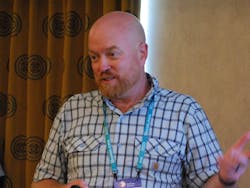Online sugar measurement bumps New Belgium Brewing capacity 30%
More than 30 years ago, Kim Jordan and Jeff Lebesch founded New Belgium Brewing in Colorado. Within five years, the brewers of Fat Tire Amber Ale had moved into the brewery and taproom that it still occupies. “We’ve done 27 building expansions and then built a new brewery in Asheville, North Carolina, in 2016,” said Matthew Gilliland, New Belgium Brewing’s brewhouse manager.
In between, the brewing company started a successful bike-to-work program, complete with company-gifted bicycles, and became a 100% employee-owned company. “In 2020, Fat Tire became America’s first certified carbon-neutral beer,” said Gilliland, himself an engineer who appreciates the use of technology to unlock delicious successes.
“Beer is turning grain into alcohol,” explained Gilliland, who spoke at this week’s Emerson Exchange. “The history of beer is the history of human civilization. We mill the malted barley, mash it and extract the sugar. We didn’t know how to improve the efficiency of the whole process until we started continuous measurement. The sensor did this. Temperature matters a lot.”
To alter the flavor of beer, you must know temperature, density and concentration. “Coriolis meters measure density and temperature,” explained Bobby Seal, test engineer, Emerson. “Temperature will affect density, but not concentration. Density measurement is based on the natural frequency of the vibrating flow tube. As the mass decreases, the natural frequency of the system increases. As the mass increases, the natural frequency of the system decreases.”
At New Belgium Brewing, Emerson’s Rosemount X-Well technology is teamed up with the company’s Micro Motion Coriolis technology. “It uses multiple measure points,” said Seal. “The process fluid temperature is 75 °C, and the ambient temperature is 30 °C. We measure density, and we have a temperature. Degrees Plato (°P) is a sugar-concentration measurement. A density of 1,051 kg/m3 at 80 °C results in a concentration of 20 °P.” The Plato gravity scale measures the concentration of dissolved solids in a wort.
Two types of sampling—interval and continuous—exist for measurement. “Interval is good for steady state,” explained Seal. “To discover trends, that’s where continuous measurement comes in. The Coriolis sensor can do this continuous measurement. The H300 Micro Motion Coriolis sensor with Rosemount X-Well technology have empowered continuous measurement.”
Capturing volume and density in the same measurement is critical to the brewing process, added Gilliland. “Brewing starts with converting starches in the malted barley kernel into fermentable and unfermentable sugars,” he said. “Sugars are then dissolved in water, which is measured as extract. The ability to measure the amount of extract in each brew reflects extract efficiency. To maximize cost savings, changes were made to maximize extract efficiency. Maximizing extract efficiency means making the same volume of beer with fewer raw materials. The data from this was recorded with a manufacturing-execution-system (MES) layer and became a daily report showing extract efficiency. Getting that in front of everyone is what started to change things.”
Because New Belgium Brewing does all of its automation in-house, it’s able to access data and see, for example, how many degrees Plato it’s getting over the process. “The closer we can get the extract efficiency to 100%, we can reduce the amount of time it takes. And that means increasing capacity,” explained Gilliland. “Getting the report out to the entire production team puts it top of mind. We want the extract the same, while speeding up the process. We can also design new brands to be as efficient as possible.”
The H300 provided the critical measurement New Belgium Brewing needed to improve throughput, increasing capacity with existing equipment. “We increased our brewing capacity throughput by 30%,” said Gilliland. “We sidestepped a $30 million spend on a new brewhouse. And raw material costs were reduced by about $172,000.”

